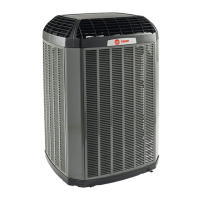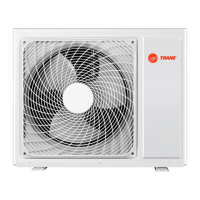
Do you have a question about the Trane ComfortLink II 4TWV8X24A1000A and is the answer not in the manual?
| Brand | Trane |
|---|---|
| Model | ComfortLink II 4TWV8X24A1000A |
| Category | Air Conditioner |
| Language | English |
Warnings about electrical hazards, leakage current, and grounding.
Precautions for handling R-410A refrigerant and oil.
Safety guidelines for service valves, brazing, and hot surfaces.
Warning about high voltage electrical hazard.
Lists compatible indoor units and controls for Link and clii modes.
Specifies the cooling and heating operating temperature limits.
Details unit dimensions and weight for various models.
Specifies refrigerant line and service valve connection sizes.
Notes on mounting, isolation, and line length limits.
Provides alternative line and valve connection sizes.
Recommends optimal placement for reliable operation and airflow.
Precautions for installing units in areas with snow and freezing temperatures.
Requirements for coastal installations, including salt shields.
Guidelines for installing the unit on a support pad.
Information on factory refrigerant charge for outdoor units.
Details on measuring line length and vertical change.
Guidelines for insulating vapor and liquid refrigerant lines.
Precautions when reusing existing refrigerant lines.
Guidelines for routing and isolating lines from structural elements.
Methods for isolating refrigerant lines within wall spaces.
Procedures for isolating lines passing through walls.
Steps for deburring, cleaning, and purging refrigerant lines.
Detailed steps for brazing refrigerant lines to service valves and driers.
Method for checking refrigerant lines for leaks using nitrogen.
Steps for evacuating the system to remove moisture and air.
Instructions for opening the gas service valve.
Instructions for opening the liquid service valve.
Specifies the maximum allowed length for low voltage wiring.
Illustrates low voltage wiring connections for Link mode.
Illustrates low voltage wiring connections for clii mode.
Details on using color-coded connectors for Link mode wiring.
Guidelines for high voltage power supply and disconnect switch installation.
Explains the status LEDs for clii mode operation.
Describes COMM LEDs for clii and Link modes.
Steps before and during applying power to the system.
Using test mode for setting system charge via subcooling.
Required temperature measurements for subcooling charging.
Worksheet for calculating subcooling corrections.
Graphical charts for subcooling corrections based on line length and lift.
Chart detailing liquid temperature, design subcooling, and gauge pressure.
Adjusting refrigerant for proper gage pressure using charging charts.
Procedures for stabilizing the system and verifying performance.
Procedure for weighing in charge below 55°F outdoor temp.
Overview of CANda navigation and main menu options.
How demand defrost measures and determines defrost needs.
Steps to initiate and execute a forced defrost test via CANda.
Checklist for final installation verification and system operation.












